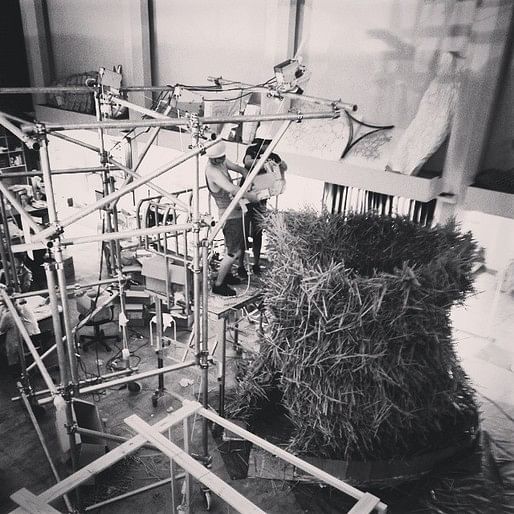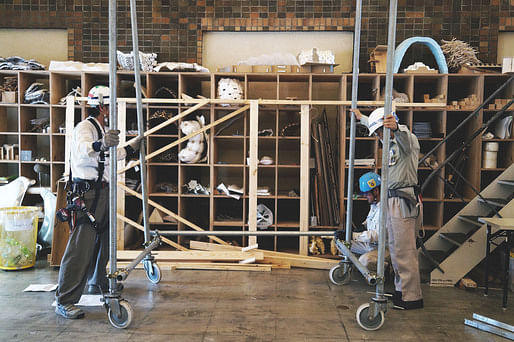

August was a big month for the project. We wanted to progress the research as far as possible before our break in September. Our primary objective was to construct a 3 meter high mock-up of the final pavilion.
We setup our projection scanning system, got our machines working more smoothly, and proposed a simple, tapered tube with a small entrance. We wanted to test our system at an architectural scale, and also see how we could work with the 3D scanning / mapping system we had been working on.






During the process, we eventually got our glue distribution system working, and made more improvements to the machine, so that, although difficult, only one person was required to operate the system.


After a week+ of work, where we tried to constantly improve our process, we achieved our goal. Our final shape was close to our target according to our scanning system. We also used the Faro Scanning system to see how accurate we were.
Finally, we continued to develop our final pavilion proposal by looking at different assembly options, as well as developing more sophisticated structural performance tests with the help of Sato Lab.




Our early structural analysis predicted a lot of problems with our form, and so we began the process of finding a way to still push our system to its limits, while still making something that could stand at the end of the day.
A student blog dedicated to ongoing happenings in and outside the Advanced Design Studies Program at the University of Tokyo.


4 Comments
Was looking for the word glue.....in comparison to say US wood framing how does this compare structurally? Is the 'harmonic' (can't remember exactly what you called it) the best form for this method of construction? Could we think of this as custom made OSB forms? Excellent work!
Hi Chris,
it's still hard to be sure of how it compares structurally to conventional framing. Even after quite a few crush tests, establishing the modulus of elasticity to a scientific degree of accuracy has been difficult. At the same time, changing the length, section, and thickness of the individual sticks had an effect on the performance of the samples as well. As one would expect, thinner, shorter sticks could pack more densely, creating more points of contact for the glue, thus making the samples with thinner profiles much stronger (up to three times). Of course, with stick framing you can always add more studs or switch to stronger sheathing material, so a side by side comparison is difficult.
We partnered with a large construction company here in Japan, and there is talk of a local architecture firm testing out the system on one of their projects, so there should be further developments of the system going forward, as there is still a lot of research and work to be done.
The final pavilion form was about 3.5 meters high with a maximum cantilever of about 1.6 meters (center to edge) and it stood for two weeks with very minimal settling.
The harmonograph design was just to give some kind of logic to the final form, you can actually build any shape within the structural capacity of the system. Likewise, you can be as high or low-tech as want in terms of using a machine or scanning system.
thank you for the response and clarification. related to Miles post on your other post...
Are you experimenting with other materials besides wood?
sorry for the late reply, Chris. We've discussed using lots of different materials / geometries, but we stuck to the timber sticks last year for the most part.
A number of us are doing new projects this year based on this dropping aggregation process but utilizing different materials.
Block this user
Are you sure you want to block this user and hide all related comments throughout the site?
Archinect
This is your first comment on Archinect. Your comment will be visible once approved.